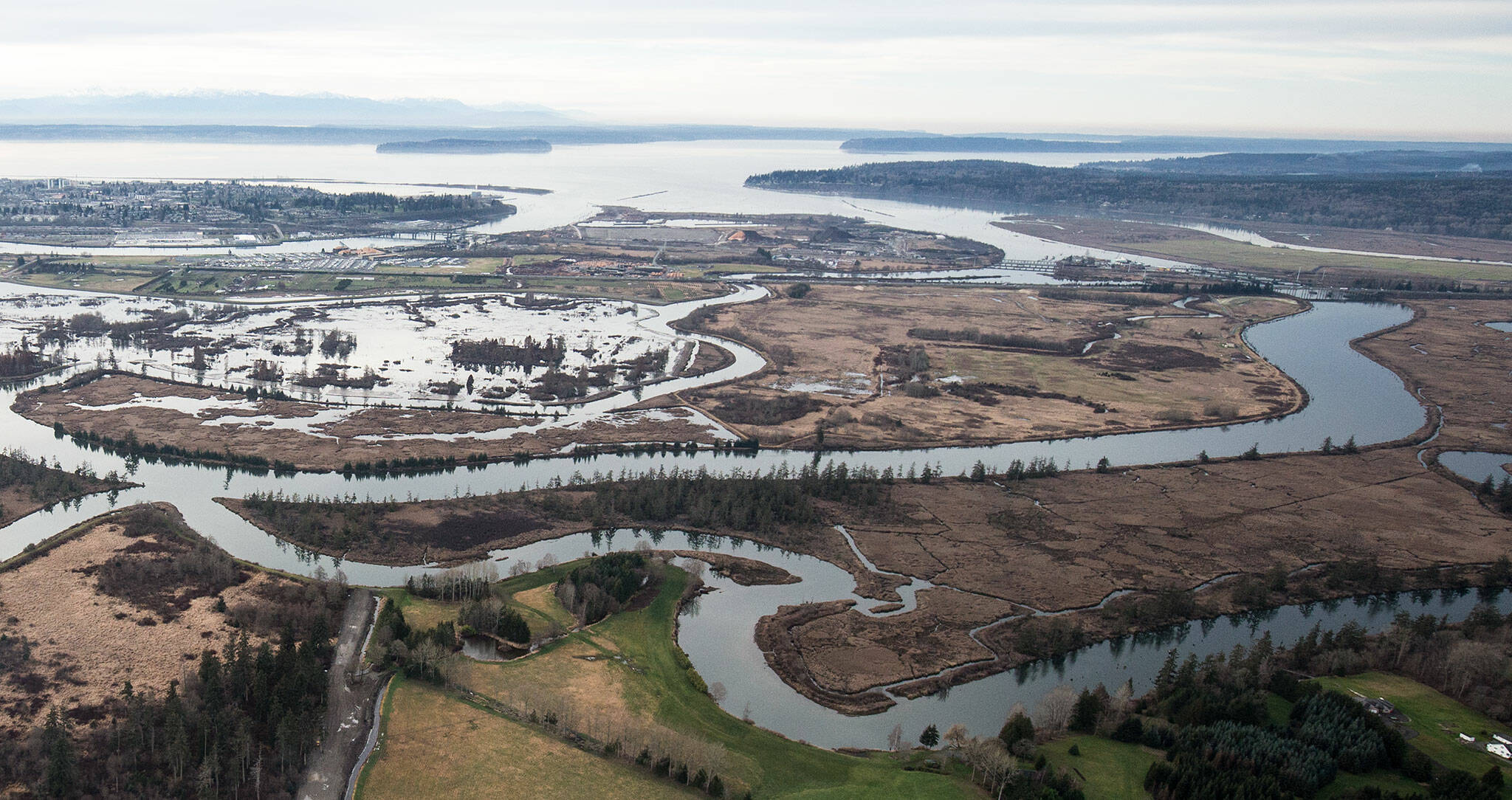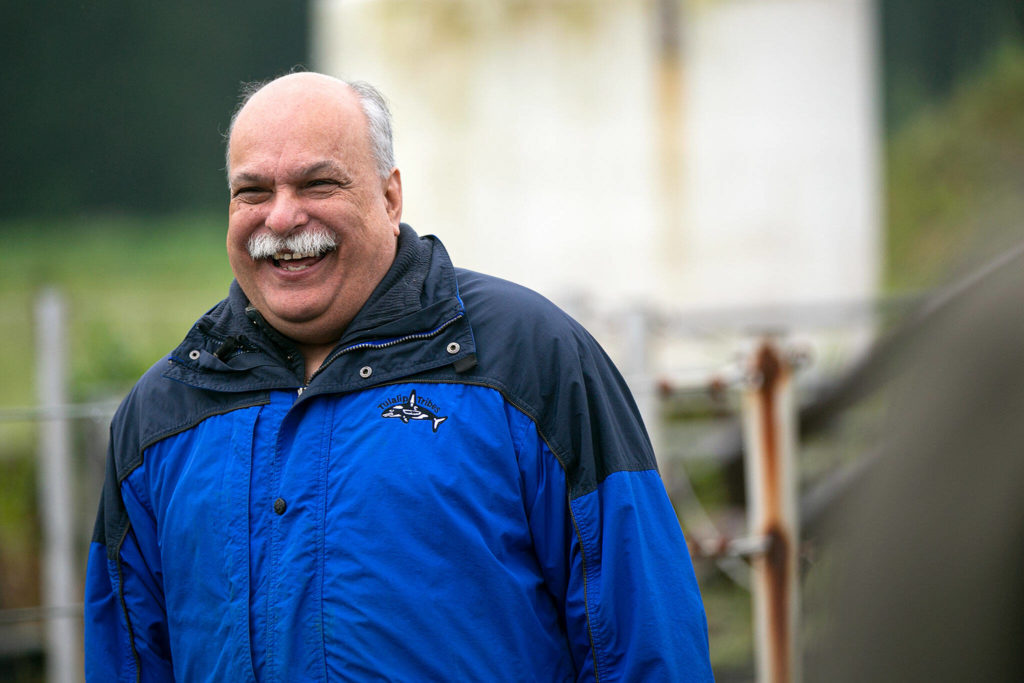By Isabella Breda / The Seattle Times
MARYSVILLE — Tacky mud clung to Daryl Williams’ black tennis shoes as he walked alongside a freshly dug channel on the east side of Interstate 5 south of Marysville. Nearby, long-billed dowitchers plunged their beaks into the muck in search of bugs.
In the early 1900s, this land was diked and drained to create farmland. Williams, environmental liaison for the Tulalip Tribes, recalls coming here as a kid to pick strawberries.
Now, excavators chip away at one of the last remaining agricultural dikes. Gradually, some of the first flows in a century began to spill into what is now known as the Blue Heron Slough. The last of four breaches on Steamboat and Union sloughs should be done by mid-October, allowing the historical tidal channels, marsh and mud flats to breathe again.
Blue herons are nesting in the willow trees. Silvery feeder fish are finding their way back into the shallow channels. Open these places up, and fish will find their way, said Joshua Chamberlin, research ecologist for the National Oceanic and Atmospheric Administration.
At 353 acres, the Port of Everett’s Blue Heron Slough restoration project is among the largest along the Puget Sound. Near completion, the project joins two nearby restoration projects at Smith Island and Qwuloolt marsh to create over 1,000 acres of recovered estuary.
At the center of this effort is an attempt to restore struggling salmon populations.
Juvenile Chinook salmon rely on lower estuary habitat to gear up for survival. Here, fish go through a process where their scales harden and change. They prepare to head into a different ecosystem — the ocean — and the most dangerous time of their life thus far.
If there’s not access to enough estuary habitat, fish get pushed right into the marine environment and their survival rate plummets, Chamberlin said.
It’s not uncommon to see Coast Salish tribes like the Tulalips at the forefront of these efforts, which are a part of broader efforts to encourage salmon recovery.
“We as tribal people see our role in the environment, generally, in a fundamentally different way than nontribal people do,” said Ryan Miller, director of treaty rights for the Tulalip Tribes. “In our culture and our way of life, we see ourselves as an integral part of the environment. And we have a role to play — to help manage the landscape and the environment in a way that perpetuates the species.”
What’s next?
In 2015, the Tulalip Tribes helped usher in the first tidal flows in over a century at the Qwuloolt estuary, not far from where the Snohomish River pours into Puget Sound. Excavators breached a levee that was installed by early settlers.
Just two years after the $20 million project wrapped up, Tulalip ecologists estimated upward of 10,000 Chinook made their return to the marshy passageways.
At the time, it was considered the state’s second-largest estuary restoration project.
Since then, the question for Brett Shattuck, senior restoration scientist for the Tulalip Tribes, has been, “What’s next?”
Over the years, about 85% of the “vital estuary habitat” in the Snohomish River delta was disconnected, primarily for agriculture. That accounts for the potential loss of up to 1.6 million Chinook smolt annually, according to a 2020 report by the Northwest Treaty Tribes.
It’s a similar story across the region, where agricultural interests have at times been at odds with salmon habitat.
What has happened in the Snohomish River delta has been replicated at other northern rivers, including the Nooksack, Samish, Stillaguamish and Skagit deltas. The Puget Sound Partnership, a state agency, has reported that these areas “have experienced the greatest absolute loss of tidal wetlands and recovery at the Puget Sound.”
Today, local and state agencies have found some workarounds that aim to balance salmon habitat and the viability of local agriculture.
In King County, the Fish, Farm, Flood advisory committee recommends projects in the Snoqualmie Valley that seek to balance those needs. In Snohomish County, the Sustainable Lands Strategy looks at about 10-mile stretches of rivers and estuary and offers proposals that would generate “net gains” for agriculture and salmon.
Seeking federal support
Crushed gravel and brittle grass crunched beneath the feet of Eric Day, Swinomish tribal senator, as he walked along the western bank of the Swinomish Channel, a piece of the Skagit River delta near the Highway 20 bridge. He wore a cedar headband adorned with two miniature carved canoes.
“What you’re looking at — even though it looks like a relatively dry field now — it’s actually very important juvenile fish habitat,” said Devin Smith, director of habitat restoration at the Skagit River System Cooperative.
Recently, Day and other conservation advocates led U.S. Rep. Rick Larsen on a tour of what once was a marshy tangle of creeks and wetlands. That remained mostly true until 1937, when the Army Corps of Engineers diked and drained over 900 acres of tideland along the channel.
The Swinomish tribal community has leased the land to farmers for years. They say they don’t want to disrupt the needs of agriculture, but they’re giving back a portion of the land for salmon.
Project leaders are hoping Larsen can help secure federal money to breach the dike and restore the historical channel alignment. It’s a multimillion-dollar ask that would bring back about 120 acres of salmon habitat. Active farmland will be safeguarded by a new dike.
On behalf of the Sauk-Suiattle Indian Tribe and the Swinomish Indian Tribal Community, the Skagit River System Cooperative is piecing back together critical salmon habitat within the tribes’ usual and accustomed fishing areas.
Since the early 2000s the co-op has been breathing life back into miles of the Smokehouse tidal channels and salt marsh on the Swinomish reservation, by dredging and using tide gates. Today, those salty waterways are once again being visited by some juvenile Chinook, Dungeness crab and other species.
Just in the past few decades, six pocket estuary sites have been restored near Swinomish, increasing the estimated Chinook smolt production by about 48,000.
And by 2020, over 480 acres were recovered in the Stillaguamish River basin, and over 1,300 in the Snohomish River basin.
There is still a real estuary capacity issue in the Skagit River basin, said Chamberlin, the NOAA ecologist. Millions of juvenile fish are forced to travel straight through to the salt water.
“The salmon sacrifices itself to us”
The Blue Heron Slough project was first envisioned in the 1990s, when the Port of Everett bought the property from Biringer Farms with estuary restoration in mind.
Not much happened for years, said Williams, environmental liaison for the Tulalip Tribes.
It took a court settlement in the late 2010s to put details to a $20 million effort to restore 9 miles of channels. That case involved the Port of Everett, who owned the property, and a group that called themselves the Port Gardner Bay Trustees.
The trustees include the Tulalip Tribes and Suquamish Tribe and NOAA, as well as the U.S. Department of Interior, U.S. Fish and Wildlife Service, U.S. Department of Commerce, and the Washington State Department of Ecology.
Removing culverts, levees and dikes to restore rivers and estuarine habitats are more or less stopgaps until more drastic restoration efforts — like breaching the four Lower Snake River Dams — can be accomplished, said Miller, the Tulalip Tribes treaty rights officer. Gov. Jay Inslee and Sen. Patty Murray said it isn’t politically feasible to remove the four dams now, in large part because of the renewable energy the dams create.
“It’s a question of values,” Miller said. “If we’re serious about what we say — we want to save salmon, we want to save southern resident killer whales — then some sacrifices have to be made.”
Suquamish Tribal Chair Leonard Forsman said restoring salmon habitat means restoring access to Coast Salish people’s culture.
Like feeding the southern resident killer whales, who are emblazoned on the Tulalip Tribes’ flag and seal. The current population of southern residents rely on Chinook for about 80% of their diet.
“We have this relationship with the killer whales, our relatives,” Miller said. “We have an oral story that tells us about how that relationship was a benefit to both species.”
Swinomish Tribal Chair Steve Edwards, 61, learned to fish in the Swinomish Channel.
“Throughout the channel there used to be salmon,” he said, walking along the west bank recently. Over the years, Edwards said, fewer and fewer fish found their way back.
Salmon, sometimes prepared by Day, the Swinomish senator, are served to elders at the Swinomish senior center. They’re a sign of restored food sovereignty, or the right to healthy and culturally appropriate food, said Valentino Villaluz, Swinomish hunting and gathering program manager.
In June, Tulalip tribal elder and lifelong fisherman Glen Gobin led a procession of drummers to the shore of Tulalip Bay. It was the tribes’ annual salmon ceremony, a tradition that honors the return of yubəč, or Chinook.
The ceremony is based around the idea that “the salmon sacrifices itself to us, so that we can be sustained,” said Miller, “and we make this guarantee to them that as a thank you that we’re always going to take care of the habitat, and all the things that are necessary for them to be sustained.”
Talk to us
> Give us your news tips.
> Send us a letter to the editor.
> More Herald contact information.


























